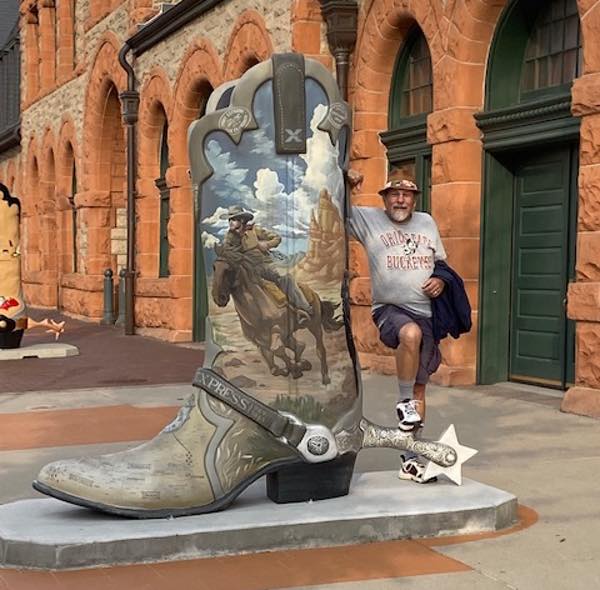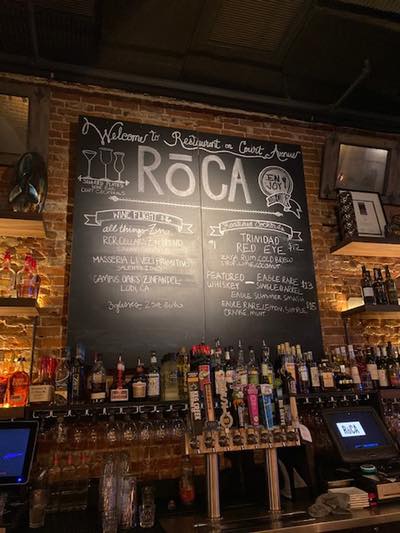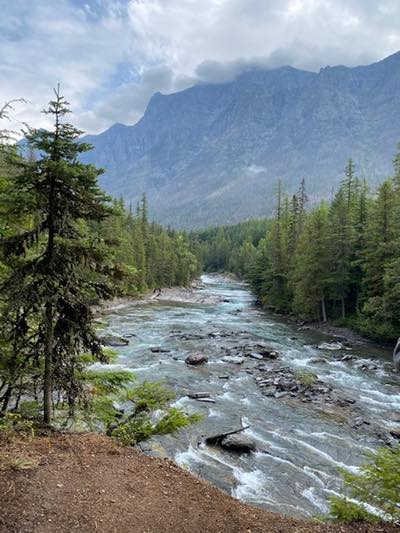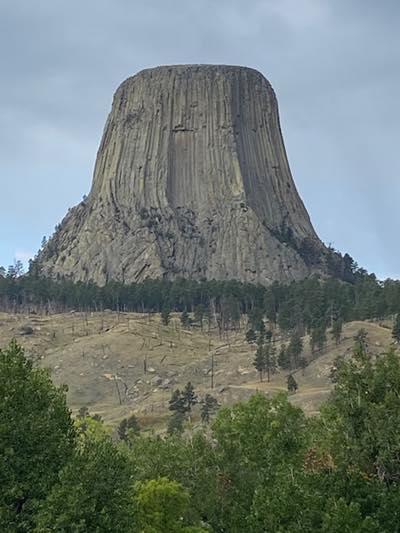
Last September, my husband Paul and I took a road trip from Cleveland to Montana to get outdoors and see new sights, a much-need relief from the pandemic. We decided to wear Cleveland and Ohio gear every day to help strike up random conversations and make some local associations. If you’re planning do a similar trip, make sure you have a supply hats, t-shirts and sweatshirts emblazoned with the names of your NEO favorite breweries, sports teams and cool places. It worked for us!
First stop: Des Moines. The yet-to-be-harvested soybeans were green on the hilly fields and towering windmills gave the landscape a settled feel. Roadside signs announced touristy places like Buffalo Bill Ranch, Fort Cody and the Thunder Road Travel Center. We were amused by the original Thunder Road Diner, with two gas pumps from the 1950s, a race car on the roof over the entrance and a climbing dinosaur.
In downtown Des Moines, the Hyatt desk clerk suggested we visit the Court Street District and the Pappajohn Sculpture Park, which lit up at night. The neighborhood was busy, and after eating deconstructed tacos at Roca, we were dazzled by the outdoor museum. On our way back to the hotel, a guy shouted “O-H” and Paul responded “I-O.”
As we continued west on I-80, the landscape became browner in western Nebraska as we crossed into Wyoming. In downtown Cheyenne, with its shops selling cowboy boots and women’s clothing, and the Cowboy Girls Museum, we felt we were “out west.”

We found a women’s suffrage movement mural and were surprised learn that Cheyenne was an early supporter. We are at Accomplice Beer Company at the train station, which listed a few bitter IPAs on its chalkboard. Paul’s Great Lakes Brewing Company shirt started a conversation with the bartender about brewing. An off-duty waitress who sat next to us at the bar told us how service industry employees can’t afford to live in high-rent towns like Cheyenne and Jackson, forcing employers to build employee barracks.
We then drove through sage brush-scattered high desert along the Wind River scenic byway, a two-lane road which passes through small settlements and Native American land. The Tetons rose in front of us as we wound our way through Bridgerton-Teton Forest where pine trees greened the landscape. Once in Grand Teton National Park, we drove along the Snake River and the hazy shapes of mountains could be seen in the distance, shrouded in smoke.

We stayed in a roomy cabin at Jackson Lake Lodge. From there it was an easy hike up “Lunch Box Hill,” one of John Rockefeller’s favorite places, and to the Mural Room, where we’d made reservations for meals. It serves expertly prepared trout and bison in a room with western murals on one side and views of the mountains on the other, but again, our view of the Teton range was obscured.
During our three-day stay, we hiked the trails along the shores of Jenny, Leigh and String Lakes where we saw mountain morasses and glaciers close up, identified footprints of bear, elk and deer, and made noise to keep the bear away. Above us, eagles soared. Fall was the perfect time to see red, gold and purple wildflowers in the Willow Flats and the yellowing aspens on the mountainsides.
On our second evening, we watched a grizzly bear munching on greens along the service path below the lodge, oblivious to the crowd that gathered to watch him, and all those warning signs we saw became real. There we found a woman from Michigan who said, “I love all the breweries in Cleveland” when she saw Paul’s shirt.
Yellowstone is less than 60 miles north of Jackson Lake Lodge, so we meandered the curves of the roads and stopped at scenic overlooks as we drove north. At the sign “Welcome to Yellowstone,” we met two couples from Toledo and chatted for a bit about what we all had experienced, and of course, we took photos for them and vice versa.

We made a beeline for the Old Faithful area and waited patiently for the geyser to erupt before we visited the Old Faithful Inn with its seven-floor lobby. The sun was past mid-afternoon when we caught glimpses of shimmery Yellowstone Lake beyond the pines on our way to 1920s-era Lake Yellowstone Hotel. We stopped to take pictures of a bison lying, almost invisible, in a field of high grass, and our patience paid off because the big animal eventually stood up to eat and we could see the profile of his head between mouthfuls.
The hotel lobby reminded me of the Great Gatsby days with its tall windows, shiny wood floors covered in tapestry and grand piano. After checking in, we met our historic Yellow Bus, originally manufactured in Cleveland, for our sunset cruise tour. We heard a talk about the history of the area, the geothermic activity under the lake, the types of trees, the changing ecosystem, the dying and rebirth, and the places where wildlife could be found. We saw bison in several places, but the most fantastic thing we saw was a pair of elk, male and female, moving together near the road, parting and then coming together again.

The sunset at the high observation point we came to was supposed to be the best sunset in the whole park. Our group stood and watched the sun lower over the lake for a good 20 minutes, while our host made a point of talking to each family group to find out more about us. When the ranger caught sight of Paul’s hat, he admitted he wouldn’t mind working in the Cuyahoga Valley National Park if given the chance.
The next day we enjoyed the eight-hour Circle of Fire tour which took us around the edges of the crevasse created by the long-ago volcano. We learned about mudpots and paintpots, geysers and hot springs, moving ground, deep blue pools, and how the steam rising above the lake’s surface was geothermal activity.
The following day we headed toward the north entrance of Yellowstone and stopped at Brim of the Falls to look down at the Yellowstone River breaking over the cliff before cascading broadly over the rocks. Although I was looking forward to seeing the pink terraces at Mammoth Hot Springs, we found them eerily dry, a disappointment.
Our next stop was the Museum of the Rockies in Bozeman, Montana, which features Montana State’s paleontological collections and photos of how the dinosaur bones are found, collected and transported. We had reservations at the boutique RSVP Motel, once the Rainbow Hotel, but its 40s decor has been given a modern redo.
Near the cash register was a sign that read “ring for champagne” and around the corner came the front desk man who poured us glasses of bubbly. The room featured oversized pillows, a black mini-fridge, L-shaped seating area, Hawaiian silk robes, and ample samples of cologne, scented face wipes and toiletries. Downtown Bozeman has a vibrant main street. We ate at a pub where our student-waitress made easygoing conversation and we could order six- and ten-ounce pours of beer in addition to a pint and a tall.
From Bozeman to Butte was high desert, and then we found the green woodlands Flathead Lake in an area known for its fruit trees.

Bad Rock B&B was our most luxurious lodging. It’s located outside Columbia Falls not far from Glacier National Park. Inside the main house was a 5,000-book library with shelves and cubbies, maps and trinkets. After we settled in, we drove to Gun Slingers in Columbia Falls to eat hearty pub food near the stage where a talented young male guitar player and female soloist sang honest music.
We were booked on a Red Bus tour and met Dave, our tour guide, at the park’s Apgar Visitor Center the next morning. Dave’s name tag says “Teddy” because he looks like Teddy Roosevelt. Our Red Bus, made by White Motors in Cleveland in 1936, was one of a fleet sold to the national parks and includes the Yellow Buses in Yellowstone.
Our first stop was McDonald Lodge, a historic lodge with portraits of important Native Americans and a walk-in fireplace. As we turned onto Going to the Sun Road, it started to rain lightly, and it was 50 degrees and windy — so much for the open roof. Dave was thrilled about the rain, which they hadn’t had for weeks. Unfortunately, at Logan’s Pass we couldn’t see any of the landscape due to the rain. We spent the afternoon walking the Oxford Bow trail through the woods in grizzly country before driving to Whitefish, an upscale town, where we found good food at Abruzzo Italian Kitchen. We ended the evening with a beautiful sunset from the patio outside our room.

At breakfast the next morning, we met a couple from Macedonia and were reminded once again that Northeast Ohioans are travelers and never far away. We walked the trail on the other side of the McDonald River, and couldn’t stop taking pictures, it was that beautiful. We had good Mexican food at Vaqueros in Columbia Falls and another sunset that evening. Then we had a day of relaxing at the B&B, reading, exploring the property, enjoying the sunset, thinking about the ride home.
The drive to Sheridan was ten hours, and we found it to be unremarkable. But it was a short trip to Rapid City and we’d have plenty of time to explore the Black Hills area, Mount Rushmore, Crazy Horse and Rapid City. On the way, we found ourselves in Deadwood, an adult Disneyland. While taking a picture of an old stagecoach and an old guy dressed in 1880s attire with long white beard and hair, the man asked, “Are you from Cleveland? It’s underrated. Let me show you what I have.” He pulled out a Cleveland Museum of Art membership card out of his wallet. He goes to Cleveland frequently, has been to the Rock Hall and on E. 4th Street for dinner!
Later, at Mount Rushmore, we met the co-owner of a Cleveland Flats tavern and chatted about the remarkable Crazy Horse monument. That night, we ate burgers at the bar at a large restaurant in Rapid City, and the native Detroit bartender said he likes going to ballgames and hanging out on E. 4thStreet in Cleveland.

Then we were off to our final stop. When we entered the Badlands from the north, Paul and I were blown away. Every view was picture-worthy, as were the prairie dogs and antelope. We stopped at every turn-off before heading to La Crosse, Wisconsin, located at the intersection of the Mississippi, Black and LaCrosse Rivers. We slept well in our big suite at the Grand Hotel and took time to explore the nationality gardens, historic Riverside Park, and the historic district before the last leg of our trip.
Despite pandemic-caused restaurant closures and climate change issues, the trip was a good reset. If you decide to go, make hotel and dinner reservations far in advance (8-10 months). We chose places to stop along the way based on driving 8-10 hours a day, and we were on I-90/I-80 all the way between Cheyenne and Cleveland. There are airports at Jackson and Glacier, but we were concerned about rental car shortages even after we reserved one, so we chose to drive. It’s good to have some idea of where you’re going, but spontaneity and getting lost at times was part of the fun. Take your local gear and be open to the experience of the open road and the sights along the way.
There’s nothing better than a good road trip, we always say.

Claudia Taller is a northeast Ohio-based writer with a special interest in travel, food and wine and yoga. Check out her work at claudiajtaller.com.
One Response to “Taking Ohio on the Road to Our National Parks by Claudia Taller”
Cynthia steinberger
Nice article…nice trip. Been to Jackson hole and surrounding area..beautiful. Glazier natl pk on my return list.